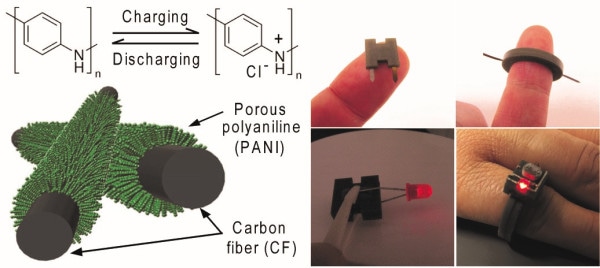Dec 21 2018
There has been a rapid growth of flexible, wireless electronic devices and they have reached the level of commercialization. However, a majority of the battery shapes are limited to rectangular and/or spherical structures, leading to inefficient use of space.
 Fabricated shape-conformable batteries based on a 3D-printing method. (Image credit: KAIST)
Fabricated shape-conformable batteries based on a 3D-printing method. (Image credit: KAIST)
Professor Il-Doo Kim’s group from the Department of Materials Science at KAIST has been successful in developing technology for considerably improving the variability of battery design through collaborative research with Professor Jennifer A. Lewis and her group from the School of Engineering and Applied Sciences at Harvard University.
The majority of existing battery shapes are optimized for pouch cells and/or coin cell. Due to the fact that the battery as an energy storage device occupies much of the space in microelectronic devices with distinctive designs, there is a need for new technology to freely alter the shape of the battery.
The KAIST-Harvard research collaboration group has been successful in manufacturing different types of battery shapes, such as H, ring-type, and U shape, with the help of 3D printing technology. 3D-printed batteries were used in small-scale wearable electronic devices—wearable light sensor rings—through the research collaboration with Dr Youngmin Choi at the Korea Research Institute of Chemical Technology (KRICT).
The researchers have used environment-friendly aqueous Zn-ion batteries to manufacture tailor-made battery packs. This system, in which Zn2+ is used in the place of Li+ as charge carriers, is far safer than the traditional lithium rechargeable batteries in which highly inflammable organic electrolytes are used. Furthermore, the processing conditions of lithium-ion batteries are highly complex because organic solvents can catch fire if they are exposed to oxygen and moisture.
Since the aqueous Zn-ion batteries used by the researchers are stable even upon coming into contact with atmospheric oxygen and moisture, it is possible for them to be fabricated under ambient conditions, and offer benefits in packaging as packaged plastic does not dissolve in water even if plastic packaging is applied with the help of a 3D printer.
In order to produce a stable cathode with the ability to be modulated in different forms and enables high charge-discharge, the researchers developed a carbon fiber current collector through electrospinning process and uniformly coated electrochemically active polyaniline conductive polymer on the carbon fiber surface for a current collector-active layer integrated cathode. Since conductive polyaniline comprises of a 3D structure, the cathode has very fast charging speeds (50% of the charge in two minutes) and can be developed without detaching active cathode materials; thus, it is feasible to produce different battery forms with high mechanical stability.
Zn-ion batteries employing aqueous electrolytes have the advantage of fabrication under ambient conditions, so it is easy to fabricate the customized battery packs using 3D printing.
Il-Doo Kim, Professor, Department of Materials Science, KAIST
3D-printed batteries can be easily applied for niche applications such as wearable, personalized, miniaturized micro-robots, and implantable medical devices or microelectronic storage devices with unique designs.
Jennifer A. Lewis, Professor, School of Engineering and Applied Sciences, Harvard University
With Dr Chanhoon Kim in the Department of Materials Science and Engineering at KAIST and Dr Bok Yeop Ahn School of Engineering and Applied Sciences at Harvard University participating as equally contributing first authors, this study was published in the December issue of ACS Nano.
This study was financially supported by the Global Research Laboratory (NRF-2015K1A1A2029679) and Wearable Platform Materials Technology Center (2016R1A5A1009926).
In the meantime, Professor Il-Doo Kim was recently appointed as an Associate Editor of ACS Nano, a highly renowned journal in the field of nanoscience.
It is my great honor to be an Associate Editor of the highly renowned journal ACS Nano, which has an impact factor reaching 13.709 with 134,596 citations as of 2017. Through the editorial activities in the fields of energy, I will dedicate myself to improving the prominence of KAIST and expanding the scope of Korea’s science and technology. I will also contribute to carrying out more international collaborations with world-leading research groups.
Il-Doo Kim, Professor, Department of Materials Science, KAIST